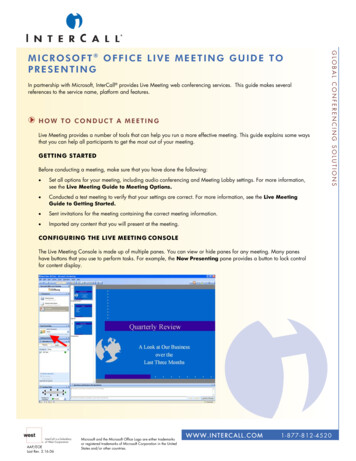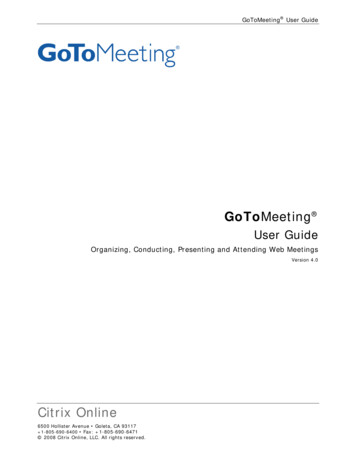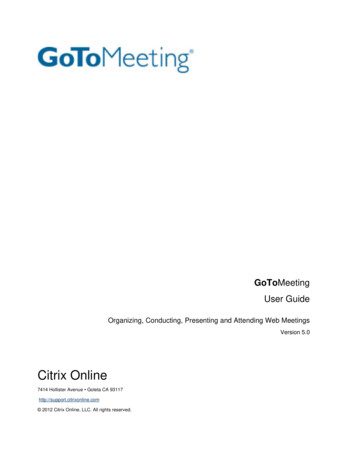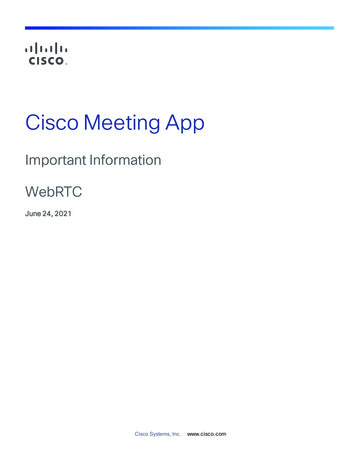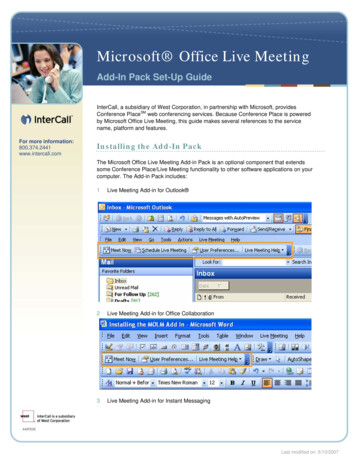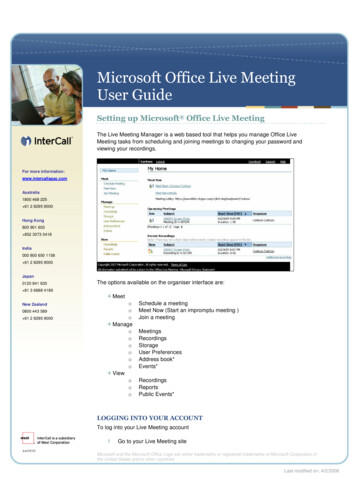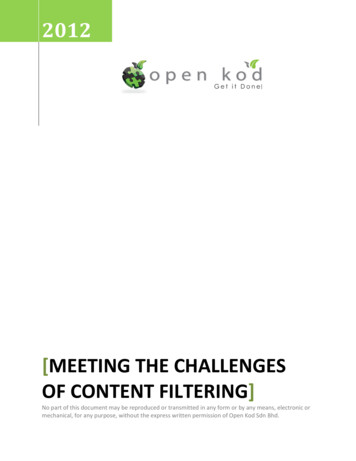
Transcription
2012[MEETING THE CHALLENGESOF CONTENT FILTERING]No part of this document may be reproduced or transmitted in any form or by any means, electronic ormechanical, for any purpose, without the express written permission of Open Kod Sdn Bhd.
Meeting the Challenges of Content FilteringContentsIntroduction – what’s the problem? . 3URL-based Filtering . 3What is Durio web content filtering?. 3Terminology . 4Transparent and Non-transparent Proxies . 5Deploying and Protecting Proxy Settings . 6Bypassing Web Content Filters . 6Getting Around Web Content Filters . 6Explicitly Proxying . 7Getting Through Web Filters. 7Catching Web-based Proxies . 8Conclusion . 9
Meeting the Challenges of Content FilteringIntroduction – what’s the problem?For many, access to the Internet is a mixed blessing; at worst, it can pose serious problems.One of the primary concerns is productivity – not much will be accomplished in an organization ifemployees are chatting, prettifying their Facebook profiles and playing web-based games.There are also moral and ethical obligations that administrators will feel the organization has, such aspreventing employees from accessing pornographic or racist websites from office computers. It is notrealistic to expect IT staff to supervise all computer use, especially if computers are accessible duringbreaks.In corporate environments, tools are needed to enforce contractual obligations, such as a company’sacceptable use policy for office computer equipment.This proposal discusses some of the problems associated with web content filtering, and poses potentialsolutions.URL-based FilteringMany programs block content classed as objectionable and market themselves as the solution to theweb content filtering problem. However, most of these programs simply filter URLs, relying on a largedatabase of pre-classified web addresses.The major drawback with such approach is that it can only effectively filter content that has alreadybeen screened by the maintainers of the database – if a site is not in the database, this is not necessarilybecause it is not undesirable; rather, the software is simply unable to make any useful classification.Given that the Internet consists of tens of billions of pages with millions more added every day, such asystem can realistically only cover a tiny percentage of existing sites, and will always be fighting a losingbattle against creators of undesirable content. Some particularly naïve URL filters can also be very easilybypassed, as will be covered later.What is Durio web content filtering?Durio web content filtering is a technically advanced method of filtering, which produces much betterresults, and is based on analyzing the actual content of a page. Using content analysis, Durio tagsparticular words and phrases with a score and a category, and looks for occurrences of these in thesource of web pages.This enables Durio to make meaningful decisions about content that has not previously been screenedby human operators, something sorely missing from pure URL-based filters. Essentially, a page’s contentis scanned for any known words and phrases, the scores associated with each are summed, and thepage blocked if the total score is above a configurable threshold value.
Meeting the Challenges of Content FilteringFlexibility and intelligence are provided by allowing phrases tohave negative and positive scores. For example, a filter thatbanned pages containing the word ‘breast’ might effectively blocksome amount of pornography, but could also block a lot ofmedical material. On the other hand, a filter that assigned anegative score to ‘breast’ when found in combination with‘cancer’ would stand a lesser chance of triggering such falsepositives.However, Durio content analysis gives you more than intelligent tagging. As the content of each andevery web page requested is analyzed, malicious code, which can exploit HTML, JavaScript, Images,ActiveX, Java, is also identified and blocked.As well as providing dynamic analysis and protection against malicious code, Durio also block searchengines that return banned content in hits. Something no URL filter could ever do.TerminologyBefore going into more detail, let’s introduce a little terminology.What we see above is a typical, simplistic network layout, consisting of client PCs, back-end servers anda firewall acting as a gateway to the Internet. By default, when a client PC requests a connection to theoutside world, the firewall simply obliges – the connection is made and the traffic is forwarded, largelyuninspected, and straight to its destination.
Meeting the Challenges of Content FilteringIn the graphic above, traffic is proxied. This means that rather than requesting connections directly tothe outside world, client PCs request a connection to the gateway itself or to some other internal server,and send requests that effectively specify a ‘forwarding address’.The primary difference between forwarded and proxied traffic is that proxied traffic is reconstructed.Traffic is received by an application – such as the content filter – over which you have administrativecontrol. This enables you to alter the traffic in any way, in both the outgoing and incoming directions,before being sent to its destination.There is a third way in which traffic can make it to the outside world; “transparent” or “interception”proxying. In this case, traffic from clients destined for the Internet is silently redirected to an internalproxy server, without the browser’s knowledge.Transparent and Non-transparent ProxiesAs mentioned above, proxying traffic comes in different flavors; transparent and non-transparent.The advantage of transparent proxying is that it does not require any client-side configuration. ClientPCs traffic is sent as normal and the router intercepts and redirects it. However, it is not always reliable,as it is not always possible to retrieve the original destination address of a web request if it is notembedded in the request itself. Also, some methods for requiring users to authenticate before they canbrowse cannot be used, as a browser will not know how to respond to authentication request fromproxy.Secure HTTP (HTTPS) also presents a problem, as when a browser has not explicitly been told to use aproxy, traffic is encrypted – and so is largely unfilterable – as soon as it leaves the client.Non-transparent proxying is much more flexible and reliable, although it does require that the webbrowser on client machines be explicitly configured to send through the proxy. This is frequently viewed
Meeting the Challenges of Content Filteringas a large drawback, perceived as hard to deploy and/or easy for end users to modify, but these areboth myths on properly managed networks.Deploying and Protecting Proxy SettingsOne way to set up PC clients for manual proxying would be to simply go around to each client machineindividually and enter the proxy settings. Not only is this incredibly tedious, but it is also a very bad idea,as users will simply be able to open up their browser’s preferences and change them.A much better idea is to have a browser settings locked down, with the locked down values themselvescentrally administrated.In the case of Internet Explorer, this is accomplished using Group Policies, which is very well integratedwith standard Windows network administration as one would expect.Opera comes second in the ease-of-administration stakes, with the concept of the ‘system fixed file’.Options users should not be able to change can be written to this file, in the same format as the defaultand user-specified options. This file can then be pushed to clients as, for example, part of a login script.Firefox makes life a little more difficult in this regard, but it is still possible – a link to one suggestedprocedure can be found at the end of this document. Two projects also exist to provide AdministrativeTemplates for Firefox settings, allowing administration through Group Policies.Bypassing Web Content FiltersThere are two basic ways to bypassing web content filters: getting around them, meaning that traffic isnot passed through the filter; and getting through them, where traffic is passed through the filter, butthe address of content – and/or the content itself – is obscured in some way.Getting Around Web Content FiltersUnfortunately, users who do not have permission to install new software, or to change the proxysettings in existing browsers, still have options open for getting their traffic around filters. There arebrowsers which do not require installation, and which will ignore locked-down settings. Portable Firefox,for example, can run entirely self-contained from a folder on a USB pen-drive. Users can then simplybrowse without any proxy.You can blocked forwarded traffic on ports 80 and 443 to preventthis, but really determined users will find or set up their ownproxies, outside the local network, accepting traffic on other ports,and browse using these.To counter this sort of activity, you could implement a default-denypolicy on your firewall, only allowing traffic to be forwarded onspecific ports. However, this alone does not put any limits on thenature of traffic on these ports, meaning they can still be used for talking to proxies.
Meeting the Challenges of Content FilteringExplicitly ProxyingThere are two ways you can stop the use of external proxies: implement a default-deny policy inconjunction with Intrusion Detection System (IDS) software, to limit usable ports and monitor the typeof traffic flowing over them; or simply refuse the forward traffic.The former requires maintaining complex rules to identify the protocols one expects to see in use, andincurs a performance overhead on the gateway. This latter simply means setting a default-deny policywith no exceptions other than for known, internal proxy servers. Run proxy servers – filtering or not –for protocols you wish to make available to clients, and deny everything else.In fact, client PCs can function perfectly well without even having a default gateway configured. The onlytraffic that can make it to the outside world is proxied traffic: proxies exist for many protocols besidesHTTP, and by enforcing their usage; you are forcing people not only to use expected ports, but expectedprotocols.Generally speaking, if a proxy server does not exist for a given protocol, it is not a protocol you wantyour clients to be using. You also gain logging, and – for supporting protocols – authentication, foreverything going on between non-privileged clients and the Internet.Getting Through Web FiltersOnce users have been prevented from getting round the web content filter, the remaining concern isthat it is able to determine what content is actually passing through it.It is in this regard that URL-only filters really show their limitations. Some systems that work this way areeasily bypassed by simply looking up a website’s IP address, and using this for accessing the site ratherthan the domain name.Other URL-obscuring tricks include looking at the Google cache of a website, which effectively returningthe requested content in a frame, appearing to the web content filter to be part of the site hosting theform. Such proxies are very simple to install, making it effectively impossible for a static URL database tocatch all of them. If a web-based proxy is hosted on an HTTPS site, then the web content filteringbecomes even more difficult, as even the content is obscured from the filter.However, Durio does not totally dismiss URL filtering as it is a good way to block non-work relatedcontent such as news, sport, shopping and travel and we use categorized URL, domain and IP addressblocklists as secondary filtering mechanisms. But remember, URL filtering is useless for things like childpornography sites where the domain will only be used for a couple of days and the baddies move inorder to keep one jump ahead of authorities.
Meeting the Challenges of Content FilteringCatching Web-based ProxiesA true web content filter like Durio is immune tomost URL obscuring tricks. Any site blockedbased on textual content is still caught whenlooked at using the IP address directly, or throughGoogle’s cache, or similar, since the content ofthe page itself is unchanged.Durio also has a Deep URL scanning option, whichessentially looks for URLs within URLs. Somesearch engines, such as Google Images, willembed the original source address of contentinto the address used to access cached or thumbnailed versions. Durio can detect this, and cancheck its database for both addresses. This also applies to some web-based proxies. Although limited toentries to entries in the URL database, this is still a powerful feature.Durio blocklist contain the characteristics of web-based proxies, and enable Durio to identify and blockthe actual forms before they can begin being used for browsing. The vast majority of web-based proxiesare unmodified installations of a handful of pieces of software, each with their own identifyingcharacteristics – button names, option strings, etc. – which are usually unmodified and detectable.As noted earlier, web-based proxies hosted on HTTPS sites present a particular challenge. If usingtransparent proxying, there is nothing at the gateway level that can be done to detect their usage, as theencryption is end-to-end. However, if clients have been configured to use a proxy server, then the dooris opened for filtering by destination domain, as the initial request for an encrypted tunnel through theproxy is made in the clear.Couple this with the fact that HTTPS is typically only provided where necessary – for example, it istraditionally used by banks and shops, but not news or research sites – and it becomes feasible toimpose a blanket block on HTTPS access, maintaining a small whitelist of accessible sites, without beingviewed as overly restrictive.Durio lends itself well to implementing this kind of configuration, with blanket blocking options for HTTPand/or HTTPS covering either all requests or requests for bare IP addresses, the latter commonlyindicating untrusted sites or attempts to bypass filtering.
Meeting the Challenges of Content FilteringConclusionAt the end of the day, locking down a network is a trade-off between flexibility and control.Wherever you choose to draw the line, it is important to be aware of the gray areas in your networktraffic, the general level of technical expertise amongst your users, and how life can be made moredifficult for those seeking to undermine acceptable usage policies.
Durio web content filtering is a technically advanced method of filtering, which produces much better results, and is based on analyzing the actual content of a page. Using content analysis, Durio tags particular words and phrases with a score and a category, and looks for occurrences of these in the source of web pages. .



